Presentation of Xcas
 ,
the swiss knife for mathematics.
,
the swiss knife for mathematics.

Abstract
Giac/Xcas is a free computer algebra system for Windows, Mac OS X and Linux/Unix (license GPL3, for commercial dual-license contact us).-
Xcas is an interface to perform computer algebra, function graphs,
interactive geometry (2-d and 3-d),
spreadsheet and statistics, programmation. It may be used as
a replacement for high end graphic calculators for example on
netbooks (for about the same price as a calculator but with much
more performances).
Xcas is based on the FLTK graphic toolkit, there is an alternate less mature interface based on QT named qcas. - Xcas offline in your browser is an interface to Giac with less functionnalities but working in a compatible browser without installation, Firefox is recommended.
-
Giac is a C++ library,
it is the CAS computing kernel, it may be used
inside other C++ programs, and also Python, Java and Javascript
programs.
Examples of software using Giac as CAS kernel: Geogebra (Java and javascript interface), HP Prime Calculator (C++), Pocket CAS (C++), CAS Calc P11 (C++). - Giac/Xcas has a compatibility mode for people used to the Maple or Mupad CAS as well as for users of TI calculators (TI89, Voyage 200, TI Nspire CAS).
- Short history: The Giac/Xcas project began in year 2000,
following the development of the CAS for HP calculators. It has
now around 150,000 lines of C++ code
(most written by B. Parisse), and around 300 pages
of English documentation (most written by R. De Graeve). It has
interfaces with php, latex, texmacs, java, javascript, python
playing the role of computation kernel.
It also interfaces with the following C/C++ libraries
PARI, CoCoA, NTL, GSL, GMP, MPFR.
It has fast implementation of algorithms
for polynomial operations: multiplication, division,
gcd of multivariate polynomials, Groebner basis computation.
Giac/Xcas was awarded the 3rd price at the Trophées du Libre 2007 in the scientific software category (presentation).
In 2013, Giac was choosen for the CAS view of the well-known Geogebra software and it was also choosen by HP as CAS for their HP Prime calculator.
Main features of Xcas
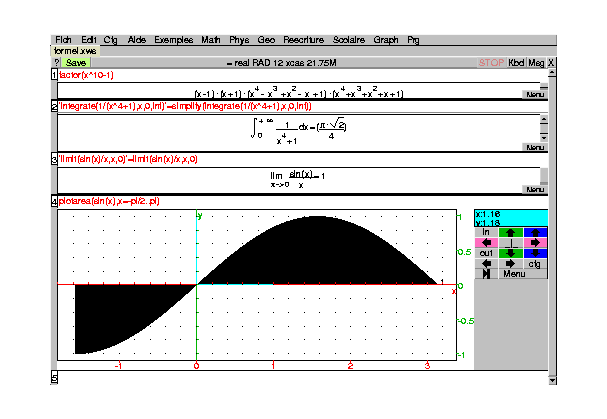
|
CAS: arbitrary precision integer and floats, integer and polynomial arithmetic (gcd, extended gcd, factorisation, ...), simplification, equation solver, partial fraction decomposition, calculus (derivation, integration, limit, series expansion), linear algebra (vectors, matrices, row reduction to echelon form, eigenvalues and eigenvectors)... |
|---|---|
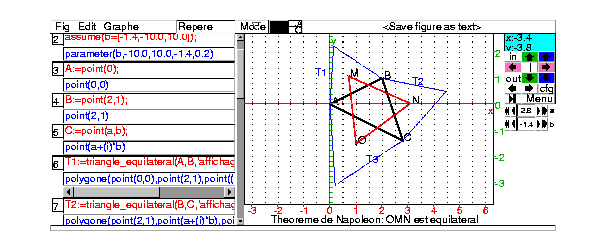
|
2-d geometry: point, segment, line, triangle, polygons, circles, conics, parametric curves, intersection, tangents... Dynamic geometry. All geometric instructions are programmable |
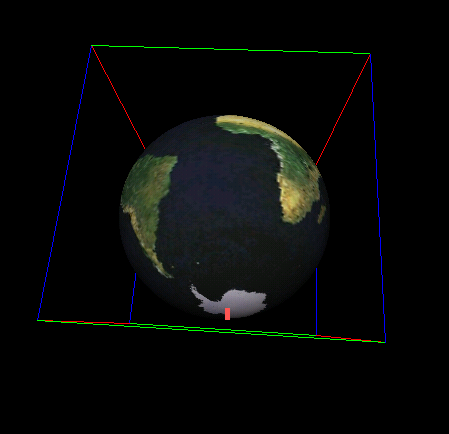
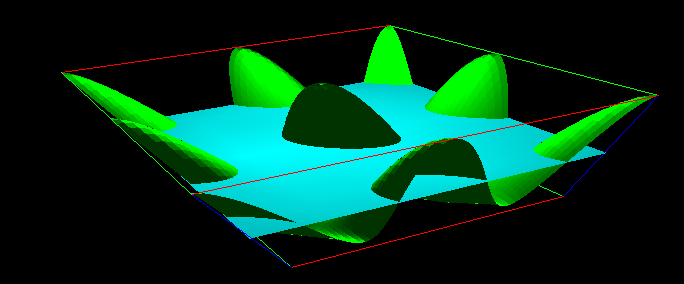
|
3-d geometry and graphs: point, segment, line, plan, triangle, polygons, circles, conics, parametric curves, surfaces, intersection, tangents... Dynamic geometry. All geometric instructions are programmable |
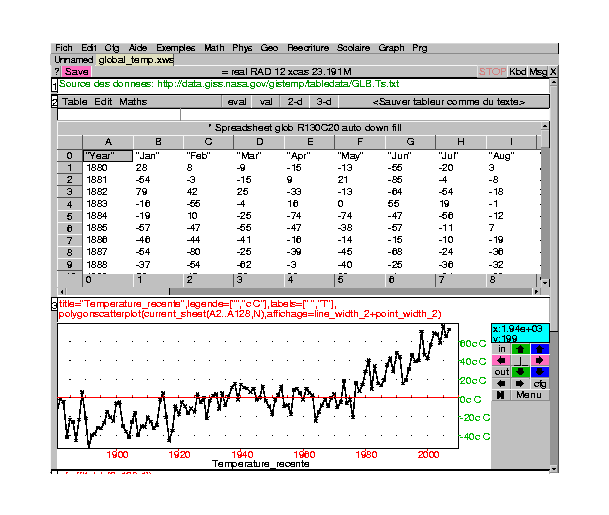
|
Spreadsheet : relative and absolute references, cells can contain formal objects (e.g 1/2, sin(x), ...), 1-d and 2-d statistics (mean, stddev, hgistogram, covariance, regressions, ...) |
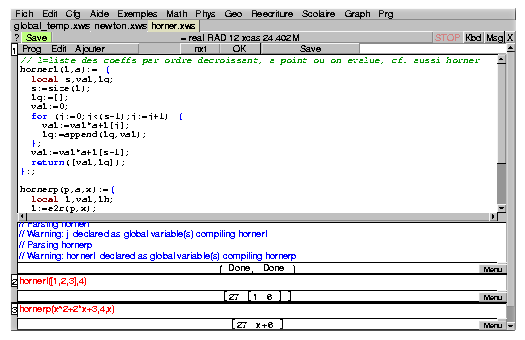
|
Programmation : functions, local variables, tests, loops. Choice of syntax (C-like, Maple, Mupad, TI89). It is sometimes possible to run a Maple, MuPAD or TI89 without user intervention inside Xcas. Program editor. Interactive debugger. |
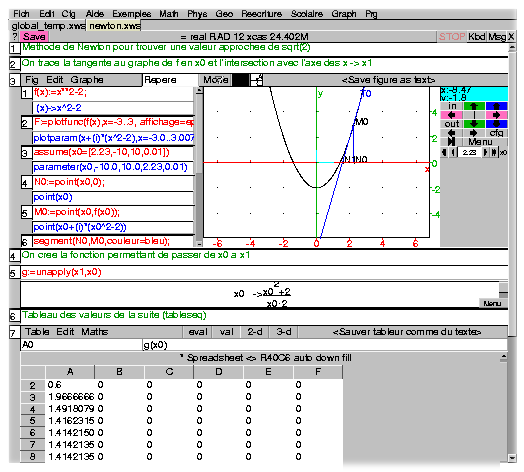
|
Mixing different level types |
Giac
Giac in console mode
Linux, Mac and Windows archives contains th giac program, that may be used standalone or inside texmacs (use Session->Insert session->giac, may be tested without install with livetexmacs), or inside emacs mupad mode (see mupacs install instruction and use giac --emacs as program command name instead of mupad -E/-R ...).Giac in Javascript
There are several interfaces using Giac compiled in Javascript: Xcas pour Firefox, Tableaunoir Xcas, a simple CAS calculatorIf you would like to run Giac in your own Javascript projetcs, run the command
npm install "https://www-fourier.univ-grenoble-alpes.fr/~parisse/giacjs.tar.gz"
then read the README.md file in the node_modules/giacjs directory.
LaTeX and Giac
You can also use giac from inside a LaTeX document,-
Under linux, the giac (or icas) commandline executable
can filter computation commands in ordinary latex files to produce HTML5 interactive
output or PDF output (this is inspired by the script pgiac described below).
You must install hevea and pdflatex. Then add (just after \begin{document})
\begin{giacjsonline} and (just befor \end{document})
\end{giacjsonline}.
If you need a computation somewhere, put one of the commands described in test.tex for example \giacinputbigmath{factor(x^4-1)} or \giacinput{plot(sin(x))}. The reader will be able to modify and/or run the command inside a compatible browser (Firefox recommended).
Compile from a terminal with the command
giac filename
instead of pdflatex filename - pgiac is a perl script that translate a .w file into a .tex file by running somme commands (lines beginning with a .g or sections beginning with .g: and ending with .end) with giac. The resulting .tex file will contain the answers of the computations and may be compiled using your prefered LaTeX distribution. By J.M. Sarlat, in French.
- tablor.sty is a LaTeX style file that automates the process of describing the variations of a function inside a LaTeX document. By Guillaume Connan, in French. Also available inside texmacs via the professor and tablor plugin by E. Corcelle.
- See also some examples of LaTeX and giac interaction by Yves Delhaye , Guillaume Connan or Alexandre Boisseau.
HP Prime
Giac/Xcas is the native CAS engine of the HP Prime calculators, and also of the Android, iOS and Windows/Mac applications emulating the HP Prime. Press the CAS key and enter the same commands as in Xcas, except for a few ones.About Xcas
(Incomplete) documentation
- Xcas tutorial on-line or PDF.
- Reference guide on-line or PDF
- Giac info documentation
Citations
If you wish to cite Giac/Xcas in a paper, you can refer toGiac/Xcas, Bernard Parisse and Renée De Graeve, version 1.9.0 (2024), https://www-fourier.univ-grenoble-alpes.fr/~parisse/giac.html
Articles/Projects where Giac/Xcas is cited
(Work in progress)- How to turn a scripting language into a domain specific language for computer algebra, by R Jolly, H Kredel - arXiv preprint arXiv:0811.1061, 2008 - arxiv.org
- Natural Editing of Algebraic Expressions, by Jean-François Nicaud 1, Denis Bouhineau 1, Les Cahiers Leibniz 169 (2008) 24 pages, HAL : hal-00591553, version 1
- Wu's Elimination Method in Graphing Calculator, by J Nie, T Chen, H Fu - Education Technology and Computer Science, 2009. ETCS '09. First International Workshop on, 2009 - ieeexplore.ieee.org
- Polynomial parametrizations of length 4 Büchi sequences, by X Vidaux -Acta Arith. 150 (2011), no. 3, 209–226. (also available as arXiv preprint arXiv:1008.2994, 2010 - arxiv.org)
- Generic, type-safe and object oriented computer algebra software, by H Kredel, R Jolly - Computer Algebra in Scientific Computing, 2010 - Springer
- DSGE Modeling on an iPhone/iPad Using SpaceTime AP Blake - Computational Economics, 2011 - Springer
- Періг О. В. Застосування вільних математичних пакетів до розв'язання задач теоретичної механіки / О. В. Періг, А. В. Кисіль, І. А. Матвєєв, Д. Ю. Міхєєнко // FOSS Lviv 2012 (Львів, 26-28 квітня 2012 року): Друга міжнародна науково-практична конференція FOSS Lviv 2012: Збірник наукових праць / під ред. Г.Г. Злобін, С.Є. Апуневич, С.В. Апуневич, Д.Є. Ванькевич. – Львів: ЛНУ ім. І. Франка. – 2012. – С. 86-89. – ISBN 978-966-8460-99-9.
- ON A THEOREM BY VAN VLECK REGARDING STURM SEQUENCES, Alkiviadis G. Akritas, Gennadi I. Malaschonok, Panagiotis S. Vigklas, Serdica J. Computing 7 (2013), No 4, 389–422
- Several articles by George E. Halkos and/or Kyriaki D. Tsilika, for example Using Xcas in Calculus Curricula: a Plan of Lectures and Laboratory Projects. Computational and Applied Mathematics Journal (American Association for Science and Technology) 1(3), 131-138, 2015.
- Hašek, R., Kovács, Z., & Zahradník, J. (2015, July). Contemporary interpretation of a historical locus problem with the use of computer algebra. In Special Sessions in Applications of Computer Algebra (pp. 191-205). Springer, Cham.
- Experiments on isoptics by dynamic coloring , by Thierry Dana-Picard and Zoltán Kovács
Thanks to
I'd like to thank (in a non-meaningful order):- Renée De Graeve for her interest, beta testing and documentation writing.
- Luka Marohnić for all the optimizations, signalprocessing and graph theory commands incorporated in Giac/Xcas version 1.4.9/1.5.0
- Jean-Pierre Branchard (Giac on-line and exomaths),
- Frédéric Han for the giacpy Python interface
- Carlos Enriqe Carleos Artime for doing the Debian packages and several fixes in the giac build process.
- Alkiviadis Akritas, Eugenia Kelepesi-Akritas, George Nasopoulos for the Greek localization.
- Jay Belanger for fixing the English user manual.
- Jose Capco for Visual c++ compiling
- Alkiviadis Akritas, Frederic Han, Fabrice Rouillier, Vanessa Vitse for discussions about some algorithms.
- Philipp Rösch for the German translation of the short help file
- Jose Manrique Lopez de la Fuente for his interest, Spanish translation of the documentation and on-line help, info about the FLVW library, Giac/xcas advertising. Have a look at his SDA project English
- Jean-Yves Avenard for the first Mac OS X port
- Dirk Eddelbuettel for including giac in his Quantian scientific linux-live CD.
- the GiNaC crew for their interest, particulary R. Kreckel and recently A. Sheplyakov for doing the hard and annoying work of autoconfiguration/automake of giac
- Mike Ady for tests and improvement suggestions especially for the Windows version.
- Joris van der Hoeven for texmacs and integration of the giac interface
- IREM de Grenoble for xcas testings in highschools, especially Michèle Gandit and her class (Grenoble), Christianne Serret and her class (Crest), and for the Mac OS X port.
- Cetril who organizes the Trophee du libre awards, where Xcas obtained rank 3 in the Scientific software category in 2007.
- Bernard Ycart for the French Xcas beginner documentation
- Michael Eisermann, Dominique Spehner, Martin Deraux, Gérard Vinel and all the students of the Université de Grenoble I following the "mat249" course who experimented Xcas and helped fixing bugs.
- Emilien Kia and Andreas Thillosen for the wxcas interface and numerous suggestions for giac, including parallel execution and the sourceforge project.
- Guillaume Connan, Georges Dubouloz, Luc Briel (and their students), Emannuel Gaunard, Yvan Duron, Martin Deraux for various suggestions of improvements.
- Francois Boisson (Clef Agreg)
- Территория без имени who pointed me to bash-optimg(-256-all) to save memory with graphic files in giac source/binaries.
- Reinhard Oldenburg for suggesting improvements (multivariate fMin with cobyla, eliminate/algsubs)
- Diego Cueva for a simple Java GUI (included in the giac JNI package).
- Stéphane Lejoly for Mac testings (including a few hard crash).
- Frédéric Han for the FreeBSD port, 32 bits binaries, python, qcas and sage interface, various suggestions and bug reports.
- Jean-Joel Bataille for testings, especially the alien-converted RPM package.
- Emmanuel Peyre (command open to open files on a Mac)
- Pierre Rochard for the first linux PPC port.
- Germain Barret for debian installation hints.
- All testers, especially (by alphabetic order) Frederic Faure, Bruno Patin, Juan Antonio Martinez Rojas, Nicolas Rosillo, ... sorry for those I forgot!
NB: All Xcas screen captures of this web page are provided under the Gnu Free Documentation Licence (GFDL).